

Human remains found in Mausoleum of First Emperor of China. Ancient Origins seeks to uncover, what we believe, is one of the most important pieces of knowledge we can acquire as human beings – our beginnings.

While many believe that we already hold such knowledge, our view is that there still exists a multitude of anomalies and mysteries in humanity's past that deserve further examination. We therefore wish to foster an open community that is dedicated to investigating, understanding and explaining the origins of our species on planet earth. To this end, we aim to organize, support and even finance efforts in this direction. Our aim is to move beyond theories and to present a thorough examination of current research and evidence and to offer alternative viewpoints and explanations to those currently held by mainstream science and archaeology.
Come with us on a journey to explore lost civilisations, sacred writings, ancient places, unexplained artefacts and scientific mysteries while we seek to reconstruct and retell the story of our beginnings. Flowing rivers of mercury. Philip Ball investigates claims that the burial chamber of China’s first emperor contains rivers of shimmering mercury. © Image Source / Alamy The Chinese emperor had done all he could to become immortal, but in vain.

His physicians had prepared herbal and alchemical elixirs, but none could stave off his decline. He had sent a minister on a voyage far over the eastern seas in search of a mythical potion of eternal life. But that expedition never returned, and now the quest seemed hopeless. Terra Cotta Soldiers on the March. China unearths ruined palace near terracotta army. Terracotta Warrior Army of Emperor Qin Shi Huang Di. Terracotta Warriors ( Mausoleum of the First Qin Emperor ) Terracotta Warriors Pit 1 , originally uploaded by Ben Burkland/Carolyn Cook.
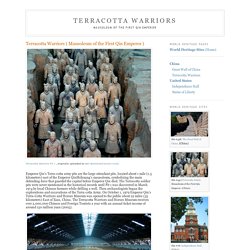
Emperor Qin's Terra-cotta army pits are the large attendant pits, located about 1 mile (1.5 kilometers) east of the Emperor QinShihuang's mausoleum, symbolizing the main defending force that guarded the capital before Emperor Qin died. The Terracotta soldier pits were never mentioned in the historical records until Pit 1 was discovered in March 1974 by local Chinese farmers while drilling a well. Emperor Qin's Terra Cotta Army. Workers digging a well outside the city of Xi'an, China, in 1974 struck upon one of the greatest archaeological discoveries in the world: a life-size clay soldier poised for battle. he diggers notified Chinese authorities, who dispatched government archaeologists to the site.
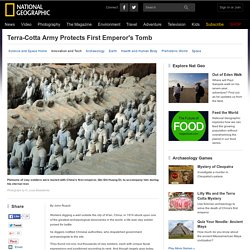
They found not one, but thousands of clay soldiers, each with unique facial expressions and positioned according to rank. BRIA 15 4 b The Law of Shi Huangdi, First Emperor of China. Fall 1999 (15:4) Clash of Cultures and Law.

First Chinese Emperor. Rob Stallard delves into the myths and legends surrounding China's most important Emperor, the article first appeared in SACU's China Eye magazine in 2007.

The Chinese film 'Hero' has recently been voted into the top 30 of 'must see' films of all time. The cinematography is truly breathtaking, and I found the historical setting fascinating too. It is set at the time of the First Emperor Qin Shi Huangdi and I wanted to know more about him. I looked in vain for an article through an archive of thirty years of SACU magazines. I knew he was associated with the Great Wall; the Terracotta Warriors and an awful lot else.
Whole books have been written about him and this short piece seeks to create a view of him different what you might find in an encyclopaedia. Qin Shi Huang Di. Qin Shi Huang Di A long time ago, China was crazy.
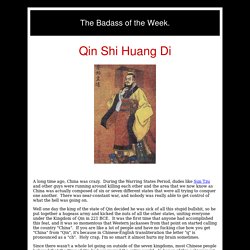
During the Warring States Period, dudes like Sun Tzu and other guys were running around killing each other and the area that we now know as China was actually composed of six or seven different states that were all trying to conquer one another. There was near-constant war, and nobody was really able to get control of what the hell was going on. Well one day the king of the state of Qin decided he was sick of all this stupid bullshit, so he put together a hugeass army and kicked the nuts of all the other states, uniting everyone under the Kingdom of Qin in 221 BCE. It was the first time that anyone had accomplished this feat, and it was so momentous that Western jackasses from that point on started calling the country "China".
Problem loading page. The mausoleum of Emperor Qinshihuang (the first Emperor of Qin) is five kilometers east of , 35 kilometers from Xi'an City in .

On its south is and to the north is . It is the biggest imperial mausoleum in ancient . In 196I, the State Council decided the Mausoleum of Emperor Qinshihuang would be a key cultural relic under state protection. Emperor Qinshihuang was named Ying Zheng and was a great politician and militarist of 's ancient feudal society. He made many political decisions that had enhanced the State of and built its military might. Qin Shi Huang: The ruthless emperor who burned books. There are two Chinese leaders whose final resting place is thronged by tourists - Mao Zedong and Qin Shi Huang, the emperor of terracotta soldier fame.
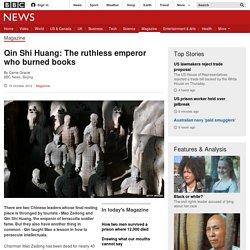
But they also have another thing in common - Qin taught Mao a lesson in how to persecute intellectuals. Chairman Mao Zedong has been dead for nearly 40 years but his body is still preserved in a mausoleum in Tiananmen Square. The First Emperor of China. Mausoleum of the First Qin Emperor. Mausoleum of the First Qin Emperor No doubt thousands of statues still remain to be unearthed at this archaeological site, which was not discovered until 1974.
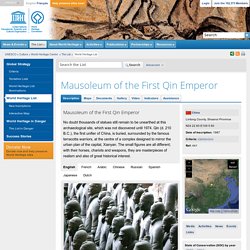
China: Ancient Tomb of First Emperor Qin Shi Huang's Grandmother Discovered in Xi'an. A huge ancient tomb belonging to the grandmother of China's first emperor Qin Shi Huang has been found in Xi'an during excavations to expand the Xi'an University of Finance and Economics campus in Shaanxi province, northwest China. According to China.org.cn, the tomb complex covers an area measuring 173,325 square metres, stretching 550m in length and 310 meters in width, and is the second largest tomb to have ever been discovered in the country. So far, archaeologists have excavated two carriages and 12 horse skeletons (each carriage would have been pulled by six horses) out of the tomb.
How One Chinese Emperor Changed the World. Each Monday, this column turns a page in history to explore the discoveries, events and people that continue to affect the history being made today. Ever heard of Qin Shi Huang? Maybe not. The Secret Tomb of China's First Emperor: Will We Ever See Inside? Buried deep under a hill in central China, surrounded by an underground moat of poisonous mercury, lies an entombed emperor who's been undisturbed for more than two millennia. The tomb holds the secrets of China's first emperor, Qin Shi Huang, who died on Sept. 10, 210 B.C., after conquering six warring states to create the first unified nation of China.
The answers to a number of historical mysteries may lie buried inside that tomb, but whether modern people will ever see inside this mausoleum depends not just on the Chinese government, but on science. Prehistoric Van Goghs: Artists Used Pointillism 38,000 Years Ago. Qin Shi Huang, the First Emperor of China. Overview Qin Shihaung Di (the first emperor) reigned for eleven years over the first large empire in the region. He was born the son of a king in a kingdom that already had plans for the conquest of every other Warring State and had been preparing for conquest for years by mobilizing the masses for massive construction projects, conscripting the people for the army, and producing the most advanced weaponry that they could.
Military might and conquest was their major goal aside from the continued rule of their king. Qin Shi Huang's Army Video - Great Wall of China. Qin Shihuangdi – the rise to power. Before its unification under Qin Shihuangdi, its First Emperor (259 – 210 BC), China was made up of seven major states which were often at war with each other, vying for power and supremacy. Historians call this time the Warring States period (475 – 221 BC). The First Emperor’s ancestors were from a small state in the far west of the region called Qin (pronounced chin). The Qin were horse breeders for the ruling Zhou people (pronounced joe). After the Zhou gave them land for the task, they began to organise themselves and develop political skills. Qin Dynasty Collapse. Although Qin was able to suppress most of the nation wild rebellions they still caused serious damage.
Qin's manpower and supplies were greatly reduced. The First Emperor: China's Terracotta Army. The First Emperor: China's Terracotta Army, The High Museum of Art, Atlanta, 16 November 2008–19 April 2009, curated by Jane Portal. Shen Yun Learn Resource. If you have trouble remembering the long line of China’s dynasties, the Qin (221-206 B.C.) is a good place to start. Part 3: The Qin Dynasty [ 221-206 BC ] Historians point out that it’s curious that climactic events around the world were unfolding around this same period…even though far apart and totally unconnected. Vision Launch Crowdfunding.
China is a country full of might, great wonders and important inventions. Its history was formed by different dynasties throughout history. Crossbow May Hold Key to Qin Dynasty’s Military Success. A remarkably well preserved crossbow dating back 2,200 years has been unearthed during a dig at the site of the famed Terracotta Army. This is the first such artefact that has been discovered whole – until now archaeologists had only come across pieces of the weapons. Qin Dynasty. Dynasty6. 2,200-year-old crossbow more powerful than modern day assault rifle discovered with Terracotta Warriors. Discovering China - The Qin Dynasty—China's First Dynasty. The Qin Dynasty in China: The Great Wall & Legalism. History of Qin Dynasty - China Education Center.
The Rise and Fall of the Qin Dynasty. Part II - Creation of a Classic, Bureaucratic Empire: Qin Dynasty, 221 - 206 BCE - Han Dynasty, 206 BCE - 220 CE. Great Wall - The Great Wall of the Qin Dynasty (the First Empire) Qin Dynasty 秦朝(221-205 B.C.) Qin Dynasty Timeline. Qin Dynasty. China: Qin dynasty (221-207 BC) Bronze banliang coin. Qin Dynasty, first emperor of China. Qin Dynasty. Qin Dynasty (221-206 BC) – Chinese History: Ancient China Facts. FC54. Qin dynasty crossbow found at China’s Terracotta Army site may reveal secret of emperor’s success.
The Qin Dynasty, History and Facts of Qin Empire. Qin Dynasty (221–206 B.C.) Newly-discovered remains redraw path of Great Wall.